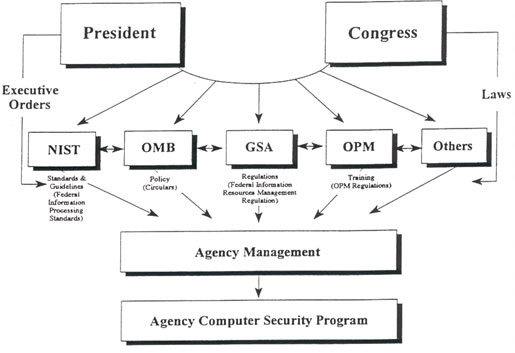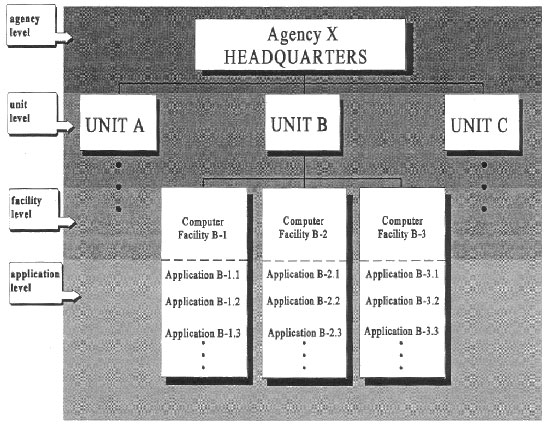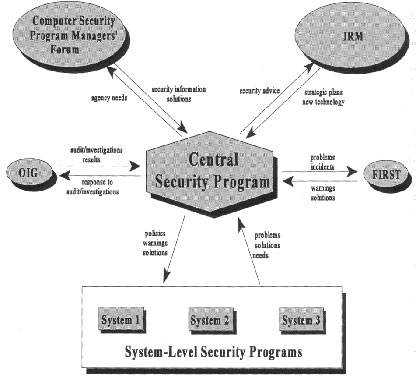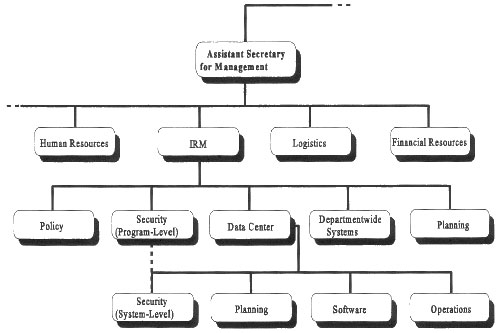
special Publication 800-12: An Introduction to Computer Security: The NIST Handbook
Click here for a printable copy for Chapter 6
CHAPTER 6:
Computer Security Program Management
Computers and the information they process are critical to many organizations' ability to perform their mission and business functions.56 It therefore makes sense that executives view computer security as a management issue and seek to protect their organization's computer resources as they would any other valuable asset. To do this effectively requires developing of a comprehensive management approach.
| OMB Circular A-130, "Management of Federal Information Resources, "requires that federal agencies establish computer security programs. |
This chapter presents an organizationwide approach to computer security and discusses its important management function.57 Because organizations differ vastly in size, complexity, management styles, and culture, it is not possible to describe one ideal computer security program. However, this chapter does describe some of the features and issues common to many federal organizations.
6.1 Structure of a Computer Security Program
Many computer security programs that are distributed throughout the organization have different elements performing various functions. While this approach has benefits, the distribution of the computer security function in many organizations is haphazard, usually based upon history (i.e., who was available in the organization to do what when the need arose). Ideally, the distribution of computer security functions should result from a planned and integrated management philosophy.
Managing computer security at multiple levels brings many benefits. Each level contributes to the overall computer security program with different types of expertise, authority, and resources. In general, higher-level officials (such as those at the headquarters or unit levels in the agency described above) better understand the organization as a whole and have more authority. On the other hand, lower-level officials (at the computer facility and applications levels) are more familiar with the specific requirements, both technical and procedural, and problems of the systems and the users. The levels of computer security program management should be complementary; each can help the other be more effective.
|
Sources of (Some) Requirements for
Figure 6.1 |
Since many organizations have at least two levels of computer security management, this chapter divides computer security program management into two levels: the central level and the system level. (Each organization, though, may have its own unique structure.) The central computer security program can be used to address the overall management of computer security within an organization or a major component of an organization. The system-level computer security program addresses the management of computer security for a particular system.
|
Sample Federal Agency Figure 6.2 shows a management structure based on that Figure 6.2 |
6.2 Central Computer Security Programs
The purpose of a central computer security program is to address the overall management of computer security within an organization. In the federal government, the organization could consist of a department, agency, or other major operating unit.
As with the management of all resources, central computer security management can be performed in many practical and cost-effective ways. The importance of sound management cannot be overemphasized. There is also a downside to centrally managed computer security programs. Specifically, they present greater risk that errors in judgment will be more widely propagated throughout the organization. As they strive to meet their objectives, managers need to consider the full impact of available options when establishing their computer security programs.
6.2.1 Benefits of Central Computer Security Programs
A central security problem should provide two quite distinct types of benefits:
- Increased efficiency and economy of security throughout the organization, and
- The ability to provide centralized enforcement and oversight.
Both of these benefits are in keeping with the purpose of the Paperwork Reduction Act, as implemented in OMB Circular A-130.
The Paperwork Reduction Act establishes a broad mandate for agencies to perform their information management activities in an efficient, effective, and economical manner...Agencies shall assure an adequate level of security for all agency automated information systems, whether maintained in-house or commercially.58
6.2.2 Efficient, Economic Coordination of Information
A central computer security program helps to coordinate and manage effective use of security-related resources throughout the organization. The most important of these resources are normally information and financial resources.
Sound and timely information is necessary for managers to accomplish their tasks effectively. However, most organizations have trouble collecting information from myriad sources and effectively processing and distributing it within the organization. This section discusses some of the sources and efficient uses of computer security information.
Within the federal government, many organizations such as the Office of Management and Budget, the General Services Administration, the National Institute of Standards and Technology, and the National Telecommunications and Information Administration, provide information on computer, telecommunications, or information resources. This information includes security-related policy, regulations, standards, and guidance. A portion of the information is channeled through the senior designated official for each agency (see Federal Information Resources Management Regulation [FIRMR] Part 201-2). Agencies are expected to have mechanisms in place to distribute the information the senior designated official receives.
Computer security-related information is also available from private and federal professional societies and groups. These groups will often provide the information as a public service, although some private groups charge a fee for it. However, even for information that is free or inexpensive, the costs associated with personnel gathering the information can be high.
Internal security-related information, such as which procedures were effective, virus infections, security problems, and solutions, need to be shared within an organization. Often this information is specific to the operating environment and culture of the organization.
A computer security program administered at the organization level can provide a way to collect the internal security-related information and distribute it as needed throughout the organization. Sometimes an organization can also share this information with external groups. See Figure 6.3.
Another use of an effective conduit of information is to increase the central computer security program's ability to influence external and internal policy decisions. If the central computer security program office can represent the entire organization, then its advice is more likely to be heeded by upper management and external organizations. However, to be effective, there should be excellent communication between the system-level computer security programs and the organization level. For example, if an organization were considering consolidating its mainframes into one site (or considering distributing the processing currently done at one site), personnel at the central program could provide initial opinions about the security implications. However, to speak authoritatively, central program personnel would have to actually know the security impacts of the proposed change -- information that would have to be obtained from the system-level computer security program.
| An organization's components may develop specialized expertise, which can be shared among components. For example, one operating unit may primarily use UNIX and have developed skills in UNIX security. A second operating unit (with only one UNIX machine), may concentrate on MVS security and rely on the first unit's knowledge and skills for its UNIX machine. |
Besides being able to help an organization use information more cost effectively, a computer security program can also help an organization better spend its scarce security dollars. Organizations can develop expertise and then share it, reducing the need to contract out repeatedly for similar services. The central computer security program can help facilitate information sharing.
Personnel at the central computer security program level can also develop their own areas of expertise. For example, they could sharpen their skills could in contingency planning and risk analysis to help the entire organization perform these vital security functions.
|
Some Principal Security Program Interactions
Figure 6.3 |
Besides allowing an organization
to share expertise and, therefore, save money, a central computer
security program can use its position to consolidate requirements
so the organization can negotiate discounts based on volume purchasing
of security hardware and software. It also facilitates such activities
as strategic planning and organizationwide incident handling and
security trend analysis.
6.2.3 Central Enforcement and Oversight
Besides helping an organization improve the economy and efficiency of its computer security program, a centralized program can include an independent evaluation or enforcement function to ensure that organizational subunits are cost-effectively securing resources and following applicable policy. While the Office of the Inspector General (OIG) and external organizations, such as the General Accounting Office (GAO), also perform a valuable evaluation role, they operate outside the regular management channels. Chapters 8 and 9 further discuss the role of independent audit.
There are several reasons
for having an oversight function within the regular management channel.
First, computer security is an important component in the management
of organizational resources. This is a responsibility that cannot
be transferred or abandoned. Second, maintaining an internal oversight
function allows an organization to find and correct problems without
the potential embarrassment of an IG or GAO audit or investigation.
Third, the organization may find different problems from those that
an outside organization may find. The organization understands its
assets, threats, systems, and procedures better than an external
organization; additionally, people may have a tendency to be more
candid with insiders.
6.3 Elements of an Effective Central Computer Security Program
For a central computer security program to be effective, it should be an established part of organization management. If system managers and applications owners do not need to consistently interact with the security program, then it can become an empty token of upper management's "commitment to security."
Stable Program Management Function. A well-established program will have a program manager recognized within the organization as the central computer security program manager. In addition, the program will be staffed with able personnel, and links will be established between the program management function and computer security personnel in other parts of the organization. A computer security program is a complex function that needs a stable base from which to direct the management of such security resources as information and money. The benefits of an oversight function cannot be achieved if the computer security program is not recognized within an organization as having expertise and authority.
Stable Resource Base. A well-established program will have a stable resource base in terms of personnel, funds, and other support. Without a stable resource base, it is impossible to plan and execute programs and projects effectively.
Existence of Policy. Policy provides the foundation for the central computer security program and is the means for documenting and promulgating important decisions about computer security. A central computer security program should also publish standards, regulations, and guidelines that implement and expand on policy. (See Chapter 5.)
Published Mission and Functions Statement. A published mission statement grounds the central computer security program into the unique operating environment of the organization. The statement clearly establishes the function of the computer security program and defines responsibilities for both the computer security program and other related programs and entities. Without such a statement, it is impossible to develop criteria for evaluating the effectiveness of the program.
Long-Term Computer Security Strategy. A well-established program explores and develops long-term strategies to incorporate computer security into the next generation of information technology. Since the computer and telecommunications field moves rapidly, it is essential to plan for future operating environments.
Compliance Program. A central computer security program needs to address compliance with national policies and requirements, as well as organization-specific requirements. National requirements include those prescribed under the Computer Security Act of 1987, OMB Circular A-130, the FIRMR, and Federal Information Processing Standards.
|
Example
Agency IRM offices engage in strategic and tactical planning for both information and information technology, in accordance with the Paperwork Reduction Act and OMB Circular A-130. Security should be an important component of these plans. The security needs of the agency should be reflected in the information technology choices and the information needs of the agency should be reflected in the security program. |
Intraorganizational Liaison. Many offices within an organization can affect computer security. The Information Resources Management organization and physical security office are two obvious examples. However, computer security often overlaps with other offices, such as safety, reliability and quality assurance, internal control, or the Office of the Inspector General. An effective program should have established relationships with these groups in order to integrate computer security into the organization's management. The relationships should encompass more than just the sharing of information; the offices should influence each other.
Liaison with External Groups. There are many sources of computer security information, such as NIST's Computer Security Program Managers' Forum, computer security clearinghouse, and the Forum of Incident Response and Security Teams (FIRST). An established program will be knowledgeable of and will take advantage of external sources of information. It will also be a provider of information.
6.4 System-Level Computer Security Programs
While the central program addresses the entire spectrum of computer security for an organization, system-level programs ensure appropriate and cost-effective security for each system.59 This includes influencing decisions about what controls to implement, purchasing and installing technical controls, day-to-day computer security administration, evaluating system vulnerabilities, and responding to security problems. It encompasses all the areas discussed in the handbook.
System-level computer security program personnel are the local advocates for computer security. The system security manager/officer raises the issue of security with the cognizant system manager and helps develop solutions for security problems. For example, has the application owner made clear the system's security requirements? Will bringing a new function online affect security, and if so, how? Is the system vulnerable to hackers and viruses? Has the contingency plan been tested? Raising these kinds of questions will force system managers and application owners to identify and address their security requirements.
6.5 Elements of Effective System-Level Programs
Like the central computer security program, many factors influence how successful a system-level computer security program is. Many of these are similar to the central program. This section addresses some additional considerations.
Security Plans. The Computer Security Act mandates that agencies develop computer security and privacy plans for sensitive systems. These plans ensure that each federal and federal interest system has appropriate and cost-effective security. System-level security personnel should be in a position to develop and implement security plans. Chapter 8 discusses the plans in more detail.
System-Specific Security Policy. Many computer security policy issues need to be addressed on a system-specific basis. The issues can vary for each system, although access control and the designation of personnel with security responsibility are likely to be needed for all systems. A cohesive and comprehensive set of security policies can be developed by using a process that derives security rules from security goals, as discussed in Chapter 5.
Life Cycle Management. As discussed in Chapter 8, security must be managed throughout a system's life cycle. This specifically includes ensuring that changes to the system are made with attention to security and that accreditation is accomplished.
Integration With System Operations. The system-level computer security program should consist of people who understand the system, its mission, its technology, and its operating environment. Effective security management usually needs to be integrated into the management of the system. Effective integration will ensure that system managers and application owners consider security in the planning and operation of the system. The system security manager/officer should be able to participate in the selection and implementation of appropriate technical controls and security procedures and should understand system vulnerabilities. Also, the system-level computer security program should be capable of responding to security problems in a timely manner.
For large systems, such as a mainframe data center, the security program will often include a manager and several staff positions in such areas as access control, user administration, and contingency and disaster planning. For small systems, such as an officewide local-area-network (LAN), the LAN administrator may have adjunct security responsibilities.
Separation From Operations. A natural tension often exists between computer security and operational elements. In many instances, operational components -- which tend to be far larger and therefore more influential -- seek to resolve this tension by embedding the computer security program in computer operations. The typical result of this organizational strategy is a computer security program that lacks independence, has minimal authority, receives little management attention, and has few resources. As early as 1978, GAO identified this organizational mode as one of the principal basic weaknesses in federal agency computer security programs.60 System-level programs face this problem most often.
This conflict between the need to be a part of system management and the need for independence has several solutions. The basis of many of the solutions is a link between the computer security program and upper management, often through the central computer security program. A key requirement of this setup is the existence of a reporting structure that does not include system management. Another possibility is for the computer security program to be completely independent of system management and to report directly to higher management. There are many hybrids and permutations, such as co-location of computer security and systems management staff but separate reporting (and supervisory) structures. Figure 6.4 presents one example of placement of the computer security program within a typical Federal agency.61
|
Example of Organizational Placement of Computer Security Functions Figure 6.4 illustrates one example of the placement of the computer security program-level and system-level functions. The program-level function is located within the IRM organization and sets policy for the organization as a whole. The system-level function, located within the Data Center, provides for day-to-day security at that site. Note that, although not pictured, other system-level programs may exist for other facilities (e.g., under another Assistant Secretary). Figure 6.4 |
6.6 Central and System-Level Program Interactions
A system-level program that is not integrated into the organizational program may have difficulty influencing significant areas affecting security. The system-level computer security program implements the policies, guidance, and regulations of the central computer security program. The system-level office also learns from the information disseminated by the central program and uses the experience and expertise of the entire organization. The system-level computer security program further distributes information to systems management as appropriate.
Communications, however, should not be just one way. System-level computer security programs inform the central office about their needs, problems, incidents, and solutions. Analyzing this information allows the central computer security program to represent the various systems to the organization's management and to external agencies and advocate programs and policies beneficial to the security of all the systems.
6.7 Interdependencies
The general purpose of the computer security program, to improve security, causes it to overlap with other organizational operations as well as the other security controls discussed in the handbook. The central or system computer security program will address most controls at the policy, procedural, or operational level.
Policy. Policy is issued to establish the computer security program. The central computer security program(s) normally produces policy (and supporting procedures and guidelines) concerning general and organizational security issues and often issue-specific policy. However, the system-level computer security program normally produces policy for that system. Chapter 5 provides additional guidance.
Life Cycle Management. The process of securing a system over its life cycle is the role of the system-level computer security program. Chapter 8 addresses these issues.
Independent Audit. The independent audit function described in Chapters 8 and 9 should complement a central computer security program's compliance functions.
6.8 Cost Considerations
This chapter discussed how an organization wide computer security program can manage security resources, including financial resources, more effectively. The cost considerations for a system-level computer security program are more closely aligned with the overall cost savings in having security.
The most significant direct cost of a computer security program is personnel. In addition, many programs make frequent and effective use of consultants and contractors. A program also needs funds for training and for travel, oversight, information collection and dissemination, and meetings with personnel at other levels of computer security management.
References
Federal Information Resources Management Regulations, especially 201-2. General Services Administration. Washington, DC.
General Accounting Office. Automated Systems Security--Federal Agencies Should Strengthen Safeguards Over Personal and Other Sensitive Data. GAO Report LCD 78-123. Washington, DC. 1978.
General Services Administration. Information Resources Security: What Every Federal Manager Should Know. Washington, DC.
Helsing, C., M. Swanson, and M. Todd. Executive Guide to the Protection of Information Resources., Special Publication 500-169. Gaithersburg, MD: National Institute of Standards and Technology, 1989.
Helsing, C., M. Swanson, and M. Todd. Management Guide for the Protection of Information Resources. Special Publication 500-170. Gaithersburg, MD: National Institute of Standards and Technology, 1989.
"Managing an Organization Wide Security Program." Computer Security Institute, San Francisco, CA. (course)
Office of Management and Budget. "Guidance for Preparation of Security Plans for Federal Computer Systems That Contain Sensitive Information." OMB Bulletin 90-08. Washington, DC, 1990.
Office of Management and Budget. Management of Federal Information Resources. OMB Circular A-130.
Owen, R., Jr. "Security Management: Using the Quality Approach." Proceedings of the 15th National Computer Security Conference. Baltimore, MD: Vol. 2, 1992. pp. 584-592.
Spiegel, L. "Good LAN Security Requires Analysis of Corporate Data." Infoworld. 15(52), 1993. p. 49.
U.S. Congress. Computer Security Act of 1987. Public Law 100-235. 1988.
|
|
Footnotes:
56. This chapter is primarily directed at federal agencies, which are generally very large and complex organizations. This chapter discusses programs, which are suited to managing security in such environments. They may be wholly inappropriate for smaller organizations or private sector firms.57. This chapter addresses the management of security programs, not the various activities such as risk analysis or contingency planning that make up an effective security program.
58. OMB Circular A-130, Section 5; Appendix III, Section 3.
59. As is implied by the name, an organization will typically have several system-level computer security programs. In setting up these programs, the organization should carefully examine the scope of each system-level program. System-level computer security programs may address, for example, the computing resources within an operational element, a major application, or a group of similar systems (either technologically or functionally).
60. General Accounting Office, "Automated System Security -- Federal Agencies Should Strengthen Safeguards Over Personal and Other Sensitive Data," GAO Report LCD 78-123, Washington, DC, 1978.
61. No implication that this structure is ideal is intended.



